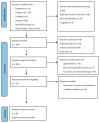Sensing and Control Strategies Used in FES Systems Aimed at Assistance and Rehabilitation of Foot Drop: A Systematic Literature Review
- PMID: 39202064
- PMCID: PMC11355777
- DOI: 10.3390/jpm14080874
Sensing and Control Strategies Used in FES Systems Aimed at Assistance and Rehabilitation of Foot Drop: A Systematic Literature Review
Abstract
Functional electrical stimulation (FES) is a rehabilitation and assistive technique used for stroke survivors. FES systems mainly consist of sensors, a control algorithm, and a stimulation unit. However, there is a critical need to reassess sensing and control techniques in FES systems to enhance their efficiency. This SLR was carried out following the PRISMA 2020 statement. Four databases (PubMed, Scopus, Web of Science, Wiley Online Library) from 2010 to 2024 were searched using terms related to sensing and control strategies in FES systems. A total of 322 articles were chosen in the first stage, while only 60 of them remained after the final filtering stage. This systematic review mainly focused on sensor techniques and control strategies to deliver FES. The most commonly used sensors reported were inertial measurement units (IMUs), 45% (27); biopotential electrodes, 36.7% (22); vision-based systems, 18.3% (11); and switches, 18.3% (11). The control strategy most reported is closed-loop; however, most of the current commercial FES systems employ open-loop strategies due to their simplicity. Three main factors were identified that should be considered when choosing a sensor for gait-oriented FES systems: wearability, accuracy, and affordability. We believe that the combination of computer vision systems with artificial intelligence-based control algorithms can contribute to the development of minimally invasive and personalized FES systems for the gait rehabilitation of patients with FDS.
Keywords: EMG; foot drop; functional electrical stimulation; inertial measurement unit; rehabilitation; sensing; stroke; vision systems.
Conflict of interest statement
The authors declare no conflicts of interest. The funders had no role in the design of the study; in the collection, analyses, or interpretation of data; in the writing of the manuscript; or in the decision to publish the results.
Figures
Similar articles
-
Can inertial measurement unit sensors evaluate foot kinematics in drop foot patients using functional electrical stimulation?Front Hum Neurosci. 2023 Nov 9;17:1225086. doi: 10.3389/fnhum.2023.1225086. eCollection 2023. Front Hum Neurosci. 2023. PMID: 38021225 Free PMC article.
-
Development of a prototype of portable FES rehabilitation system for relearning of gait for hemiplegic subjects.Healthc Technol Lett. 2016 Sep 12;3(4):284-289. doi: 10.1049/htl.2016.0045. eCollection 2016 Dec. Healthc Technol Lett. 2016. PMID: 28008365 Free PMC article.
-
A sensor fusion approach for inertial sensors based 3D kinematics and pathological gait assessments: toward an adaptive control of stimulation in post-stroke subjects.Annu Int Conf IEEE Eng Med Biol Soc. 2018 Jul;2018:3497-3500. doi: 10.1109/EMBC.2018.8512985. Annu Int Conf IEEE Eng Med Biol Soc. 2018. PMID: 30441133
-
Functional electrical stimulation on improving foot drop gait in poststroke rehabilitation: a review of its technology and clinical efficacy.Crit Rev Biomed Eng. 2013;41(2):149-60. doi: 10.1615/critrevbiomedeng.2013007621. Crit Rev Biomed Eng. 2013. PMID: 24580568 Review.
-
A systematic review on functional electrical stimulation based rehabilitation systems for upper limb post-stroke recovery.Front Neurol. 2023 Dec 8;14:1272992. doi: 10.3389/fneur.2023.1272992. eCollection 2023. Front Neurol. 2023. PMID: 38145118 Free PMC article.
Cited by
-
Development and testing of range of motion driven motor unit recruitment device for knee rehabilitation: A randomized controlled trial.MethodsX. 2025 May 21;14:103382. doi: 10.1016/j.mex.2025.103382. eCollection 2025 Jun. MethodsX. 2025. PMID: 40584164 Free PMC article.
-
Optimization of MIMU Mounting Position on Shank in Posture Estimation Considering Muscle Protuberance.Sensors (Basel). 2025 Apr 3;25(7):2273. doi: 10.3390/s25072273. Sensors (Basel). 2025. PMID: 40218786 Free PMC article.
References
-
- Alouane M.A., Rifai H., Kim K., Amirat Y., Mohammed S. Hybrid impedance control of a knee joint orthosis. Ind. Robot Int. J. Robot. Res. Appl. 2019;46:192–201. doi: 10.1108/IR-08-2018-0165. - DOI
-
- Page A.P., Freeman C.T. Point-to-point repetitive control of functional electrical stimulation for drop-foot. Control Eng. Pract. 2020;96:104280. doi: 10.1016/j.conengprac.2019.104280. - DOI
-
- Nori S.L., Stretanski M.F. StatPearls. StatPearls Publishing; Treasure Island, FL, USA: 2024. [(accessed on 28 July 2024)]. Foot Drop. Available online: http://www.ncbi.nlm.nih.gov/books/NBK554393/ - PubMed
Publication types
LinkOut - more resources
Full Text Sources
Miscellaneous



